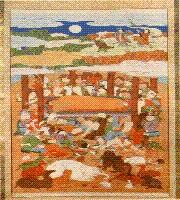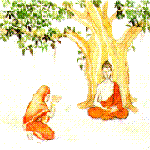 Rohatsu Sesshin
Rohatsu Sesshin
The week between December 1st and 8th is called Rohatsu Sesshin, which is a whole week of intensive zazen. The custom has its roots in the Buddha’s own attainment of enlightenment after a week of meditation. Following the example of the Buddha, t he Zen monks meditate for a whole week , regardless of the cold weather. Many lay practitioners also participate in this week of intensive zazen since it is the one week when they can devote themselves fully to zazen in a monastery without any outside interference. During zazen, practitioners often experience leg pain from the constant kneeling. However, by focusing one’s mind, an indescribable inner composure and sense of expansiveness can be attained. Trying to attain this state in an impatient frame of mind will only lead to a sense of narrowness and closure. But immersing both mind and body in zazen will lead to the attainment of Buddhahood, radiating naturally from the inner depths of mind. The whole week can be called a week of completely handing oneself over to the Buddha.
Ceremony Commemorating the Awakening of Shakyamuni Buddha (Jodo-e) December 8th
December 8th is the day we commemorate Shakyamuni Buddha’s realization of the Way. Following many years of difficult ascetic practice, Shakyamuni sat in zazen beneath the Bodhi tree. At dawn on December 8th, Shakyamuni saw the morning star and realizing awakening, he then became Shakyamuni Buddha. He was no longer an ordinary, common person and instead had achieved the brilliance by which to free all of humankind.
In Soto Zen School, we call this day Jodo-e and perform a ceremony as a gesture of our gratitude to Shakyamuni Buddha. It is also customary to practice zazen on this day.
Let us visit the temple to honor the virtue and wisdom of the Buddha and diligently proceed along the Way of faith.
Commemoration ceremony of the Second Patriarch’s cutting off his forearm (Danpi Ho-on Sesshin) December 9th and 10th
On December 9th and 10th , Danpi Ho-on Sesshin and intensive zazen take place. Danpi means to cut off one’s hand, an episode illustrating the devotion of the Second Patriarch Eka. On the night of December 9th in 520 CE, the Second Patriarch Eka visited the First Patriarch Bodhidharma and stood outside in a snowstorm without sleeping. Noticing him, Bodhidharma asked, “Why are you standing outside in the snow? What do you seek?” Eka implored him in tears, “Please teach me the truth of the Buddha’s Dharma and save me.” Bodhidharma turned him down with the words “The true teaching cannot be gained half-heartedly, but only with suffering.” Hearing these words, Eka secretly took out a sword and cut off his left forearm to show his determination. Because of this, he was admitted and spent six years in hard training. He went on to propagate the Buddha Dharma and became the Second Patriarch. The Danpi Ho-on Sesshin is the time to commemorate his dedication. On the day of commemoration the monks meditate without sleep for one full day and night.
end-of-year events (O-misoka) December 31st
Eiheiji:
On December 27th, the rice-cake pounding ceremony takes place and great quantities of rice-cakes are made. Three types of rice-cakes are prepared on the day. One is rice-cakes in the shape of a traditional mirror, to be offered to the Buddhist statues enshrined in the temple. The second type of rice-cakes is called jubyo (lit. the rice-cake for longevity). These are presented to Zen masters in the monastery with the wish for their good health. The third type of rice-cakes is for the monks to eat during the first three days of the New Year. At six o’clock on the evening on that day, the monks gather at the temple kitchen in the building called Kichijo-kaku. They start pounding the rice-cakes after praying for the good health of their masters as well as for the rest of the temple. They use four large mortars to make more than 500 pieces ranging from very large to small. It is a boisterous event where the normally quiet monks come to life, smiling and shouting, while pounding away in a kitchen covered in white flour.
 The end of December sees a series of year-end events. Events such as the rice-cake pounding, cleaning, alms begging for the needy and the striking of the New Year’s Eve bell. The founder, Dogen, once preached at his New Year’s Eve sermon that one should attain mastery of his/her discipline by year end, otherwise the daily practice of the last 360 days would be in vain: a reminder of the importance of each day.
The end of December sees a series of year-end events. Events such as the rice-cake pounding, cleaning, alms begging for the needy and the striking of the New Year’s Eve bell. The founder, Dogen, once preached at his New Year’s Eve sermon that one should attain mastery of his/her discipline by year end, otherwise the daily practice of the last 360 days would be in vain: a reminder of the importance of each day.
<[the New Year]January 1st-
The morning of the New Year’s at Eiheiji starts at 3 a.m. Monks meditate soon after they get up, starting their new year with a lungful of the fresh, cold, almost spring-tinged, air.
For the first three days of the New Year, there is a series of New Year ceremonies known as shusho-e (lit. New Year ceremonies). On January 1st, sutras of six hundred Buddhist scrolls are chanted and the monks offer prayers for the flourishing of the Dharma, the peace of the world, the prosperity of the people and the peace of the nation. On January 2nd is a ceremony in which the great praj na-paramita sutra ( Hannya Kyo) is chanted, and on January 3rd, a ceremony praising the Buddha (Tanbutsu-e). Every day, more than ten thousand worshippers come to receive the Buddha’s blessing.
Until the middle of January, such ceremonies as the Jinjitsu-en are held (entertainment by and for the monks who are divided into groups according to dormitory), and the first calligraphy ceremony of the year. The entertainment event in particular sums up the festive New Year atmosphere and is where the personalities of the monks and the mood of each dormitory are displayed.
Sojiji:
After the Rohatsu S esshin (December sesshin) is over, New Year preparations such as year-end cleaning, rice-cake pounding and preparations for the New Year’s ceremony take place. At the end of the year, the monks beg for alms for the needy. The monks make their own footwear, symbolizing a firm foundation for both mind and body, and walk around Tsurumi Town.
On December 31st, the monks must be in bed by 6 p.m. and be up again at 11 p.m. on the same evening to the ringing of a bell ready for the New Year. The Mukai-karamon Chinese style-gate, normally closed, opens at a quarter to midnight and the bell starts to toll. The bell tolls 108 times to symbolize the eradication of worldly desires. On top of that, Sojiji allows each and every visitor a single strike on the bell. Being a time of year when unexpected incidents and disasters are likely to occur, it is a great opportunity for the visitors to strike the bell with the hope that their worldly desires will vanish and that their new year be a good one.
[the New Year]January 1st-
At a quarter past midnight on New Year’s Day, the first ceremony of the year known as the New Year’s Grand Service (Hatsumode-daikitoukai) takes place. At the Founder’s Hall, all of the monks who serve the temple gather, and the ceremony is led by the leading Zen Master with prayers for the safety of the temple, the happiness of the people and the peace of the nation. Following this ceremony, other ceremonies are held in the temple precincts, such places as Koshakudai, where Daikoku, the god of prosperity, is enshrined and Sanpo-den where Sanpo Daikojin, the local god of the temple yard, is enshrined. January 1st is filled with the chanting voices of the monks offering up Buddhist sutras in the temple.
After New Year, comes the coldest season. A ccording to the lunar calendar, Shokan (lit. small coldness) sets in the middle of January. The monks gather winter alms in the coldest season of the year until February 2nd. During this period, after the afternoon service, more than 100 monks set out in straw sandals and traditional gloves for the neighboring town, Tsurumi where they beg for between an hour and a half and two hours.
 The Founder’s Birthday (Koso gotan-e) January 26th
The Founder’s Birthday (Koso gotan-e) January 26th
January 26th is the birthday of Dogen (the Founder of Soto Zen). Dogen was born in Kyoto on January 2nd (January 26th in the solar calendar). On January 26th, two ceremonies are held in celebration of his birth, one in the morning and the other in the afternoon. In the morning ceremony, a scroll with a painting of Dogen is hung in the Lecture Hall. A pail is placed in front of the painting containing holy hot water in which such incense as aloes, sandal wood have been boiled. In the afternoon is the ceremony of appreciation (Ho-on Ko). Special shomyo Buddhist music is chanted as an expression of gratitude.
Nirvana Ceremony, Commemorating the Buddha’s Death (Nehan-e) February 15th
This is the day that Shakyamuni Buddha died near the town of Kushinagara on the banks of the Hiranyavati River. A big scroll depicting the Buddha entering Nirvana is hung in the temple and a ceremony expressing our gratitude to the Buddha is performed.
It is said that at the time of his death the Buddha was sleeping on a bed that had been prepared between two sala trees; his head to the north, his face to the west, and his right hand for a pillow. At that time, white flowers bloomed on the sala trees and fell continuously.
Many of his disciples, the king and his family, men and women of all ages, and even birds and animals gathered, sighing with sadness. The Buddha gave his last discourse, expounding the fundamental truth – even though the physical body dies, the Dharma is eternal; in order to see the Buddha, it is necessary to see the Dharma. In this way, he taught his disciples the precepts and the way they should maintain the practice of Buddha’s Way. This sermon is called the Yuikyogyo, the Last Teaching of Shakyamuni Buddha.
Nehan Dumplings
In connection with the Nirvana Ceremony, there are some districts in Japan where, from long ago, dumplings have been made either at the temple or in individual homes. These dumplings, called “flower dumplings,” are first offered to Shakyamuni Buddha and then distributed to people who attend the ceremony.
It is generally said that people who eat these dumplings will not suffer from sickness or disaster and for this reason many people come to the temple on the day of this ceremony.
The whole text is originated from http://global.sotozen-net.or.jp




